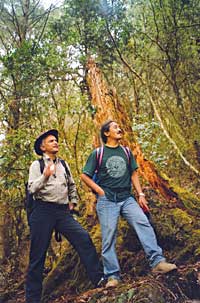 In a country that has nursery rhymes about flies on the wall, it's not surprising to find the song of the moment is not about unrequited love-even in February-but about sheep's wool. Everybody seems to be singing or humming Bheda ko oon jasto, and most don't know more than those four words.
In a country that has nursery rhymes about flies on the wall, it's not surprising to find the song of the moment is not about unrequited love-even in February-but about sheep's wool. Everybody seems to be singing or humming Bheda ko oon jasto, and most don't know more than those four words. The popularity of the song was helped by the documentary Bheda ko oon jasto.in search of a song that played during Film South Asia '03, and has just completed a screening tour in towns across Nepal to packed halls and enthusiastic crowds.
It starred, if the word can be used in context of a documentary, journalist Narayan Wagle, and Amrit Gurung and Daniel Karthak of the well-known Nepali rock band Nepathya. Wagle, who heard the tune on a Langtang trek sings it for the musicians who decide to trace the origins of the song-a journey that takes them to the goths of Thulo Syabru and Gosainkunda.
The song Bheda ko oon jasto, however, currently exists in three avatars: what the shepherds sing in the high mountains below Langtang, the Nepathya remake that followed the documentary and singer Deepesh Kishore Bhattarai's Bheda ko oon jasto that was released last year. It seems no one owns a folk song: it belongs to the people, so different versions-interpretations-of one tune abound. In Western music, it bears a passing resemblance to the Grateful Dead's prolific takes and retakes. Just better.
Snatches of the song from the documentary are atmospheric. The people sing the Nepali and Tibetan lyrics with a Tibetan accent and beat, true to their roots. They sing about what they know: lover's cheeks that are as red as the apples of Syabru and of course, clouds that look like sheep's wool. Deepesh Kishore Bhattarai is known for his folk songs and his version launches straight into the original song with backups going shakachuk and an overt synth presence. The occasional whoop of "Ya hai!" and the ubiquitous flute interval is perhaps an attempt to maintain folk credibility. But Bhattarai's sound is psuedo-folk, if there is such a genre: the folk song has undergone a pop metamorphosis to take on urban sensibilities for the city listener.
 Which isn't to say Nepathya have a faithful rendition of Bheda ko oon. But they do have a 38 second introduction that incorporates folk instruments. While Bhattarai picked pop, Nepathya relied on rock overtones for a more contemporary feel. The "shakachuk" is replaced by "shikshik"-a sound viewers will recall from the documentary, and the synthesiser is replaced by guitar riffs and drums. Nepathya rejects the lilt for punchy energy that is reflected in the way lead vocalist Amrit Gurung delivers the lyrics in a distinctly Sherpa cadence.
Which isn't to say Nepathya have a faithful rendition of Bheda ko oon. But they do have a 38 second introduction that incorporates folk instruments. While Bhattarai picked pop, Nepathya relied on rock overtones for a more contemporary feel. The "shakachuk" is replaced by "shikshik"-a sound viewers will recall from the documentary, and the synthesiser is replaced by guitar riffs and drums. Nepathya rejects the lilt for punchy energy that is reflected in the way lead vocalist Amrit Gurung delivers the lyrics in a distinctly Sherpa cadence. In the final analysis, one is not better than the other. They just present different facets to a tune that is copyrighted to all Nepalis. And we are grateful for whatever way our music thrives. "Lok geet belongs to the people, so it's unfair to call into question artistic interpretations," says Deepesh Shrestha, program director at Hits FM 91.2. "However, I will say that I prefer Bhattarai's rendition because the style and arrangement is more appropriate to the song, besides Nepathya had something to work off when they released their version. The bottom line is that neither have true Nepali pan."
With rumours of a hip hop outfit going into the studio to record their take on Bheda ko oon jasto, no matter what we make of it, one thing is assured: the song will survive long into the future.


